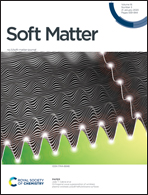Mixing–demixing transition in polymer-grafted spherical nanoparticles†
Abstract
Polymer-grafted nanoparticles (PGNPs) can provide property profiles that cannot be obtained individually by polymers or nanoparticles (NPs). Here, we have studied the mixing–demixing transition of symmetric copolymer melts of polymer-grafted spherical nanoparticles by means of coarse-grained molecular dynamics simulation and a theoretical mean-field model. We find that a larger size of NPs leads to higher stability for a given number of grafted chains and chain lengths, reaching a point where demixing is not possible. Most importantly, the increase in the number of grafted chains, Ng, can initially favour the phase separation of PGNPs, but a further increase can lead to more difficult demixing. The reason is the increasing impact of an effective core that forms as the grafting density of the tethered polymer chains around the NPs increases. The range and exact values of Ng where this change in behaviour takes place depend on the NP size and the chain length of the grafted polymer chains. Our study elucidates the phase behaviour of PGNPs and in particular the influence of the grafting density on the phase behaviour of the systems, anticipating that it will open new doors in the understanding of these systems with implications in materials science and medicine.



 Please wait while we load your content...
Please wait while we load your content...